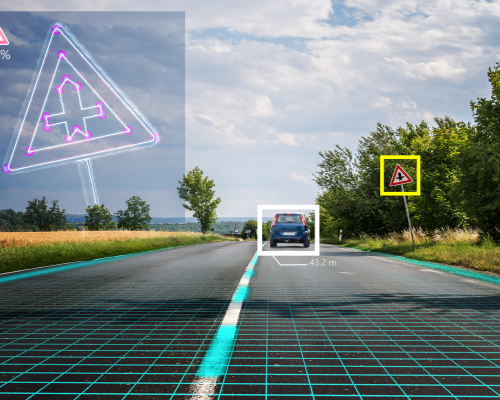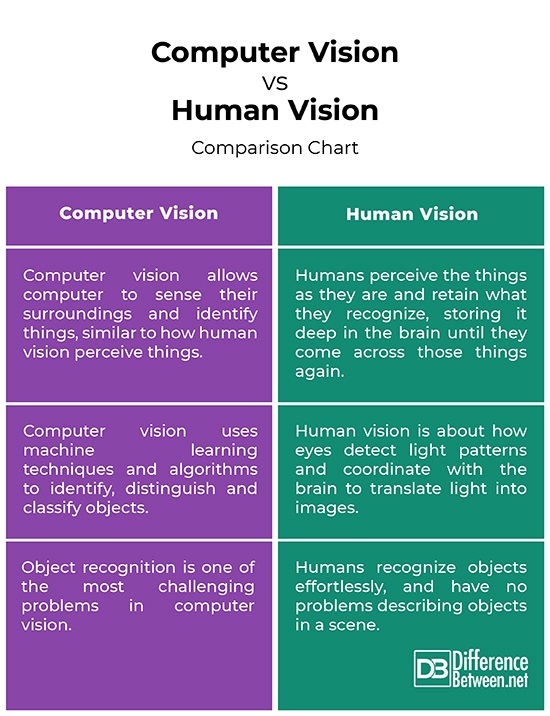Difference Between Computer Vision and Human Vision
Computer vision shares a lot of similarities with human vision, but there are significant differences between the two. Human vision is a complex process which is still not understood completely. Computer vision is a technological implementation of human vision that enables computers to achieve human vision capabilities. We take a look at the two and try to understand the differences between them.

What is Human Vision?
Human vision is a complex process that is still not completely understood. Vision is clearly one of the most important of the five senses and it is the one that humans have to come to depend upon above all others. Vision is the special sense of sight that revolves around light. It’s fascinating how the human vision system perceives and interprets things. We see things as they are – trees in a forest, books on a shelf, widgets in a factory, cars on the road, and clouds in the sky. No obvious deductions are needed and extra effort is required to interpret each object or scene.
All these things depend on the eyes and how they detect light patterns and coordinate with the brain to translate light into images that we see. Human eye is a complex optical system much like a camera; the light bounces off an object you’re looking at and enters the eyes through the cornea. Next, the light passes through the pupil and the iris, which together control the amount of light entering the eyes. When all of them work together, they focus light on the back of the eye called the retina. When light hits the retina, the tiny cells in the retina turn it into electrical signals.

What is Computer Vision?
Computer vision is a form of artificial intelligence (AI) that enables computers to see and understand the content of digital images such as photos and videos. It allows computer to sense their surroundings and identify things, similar to how human vision perceive things. They use algorithms to collect pre-defined features of human vision and generate models and programs to simulate the abilities of human vision into computers. It gives computers the ability to acquire, analyze and process visual information just the way human vision does.
One of the most common implementations computer vision is facial recognition which is used to secure access to your mobile devices. The idea behind computer vision is to extract useful information from images and take appropriate action based on that information. It basically replicates the human vision system so computers could do much of the work of humans. For simple mechanical tasks this is not particularly difficult, but for complex tasks, the machine must be trained to visualize and understand visual data.
Difference between Computer Vision and Human Vision
Perception
– Humans see objects, scenes, patterns, and people as they are, like trees in a landscape, people inside a car, clouds in a sky, or books in a shelf. Humans perceive the things as they are and retain what they recognize, storing it deep in the brain until they come across those things again. No obvious deductions or extra effort is required each object or people. Computer vision, on the other hand, allows computer to sense their surroundings and identify things, similar to how human vision perceive things.
Working
– Human vision is all about eyes and how they detect light patterns and coordinate with the brain to translate light into images that we see. Human eye is like a camera which needs light; when light hits the eyes, it forms a particular angle and the image is formed in the retina in the back of the eye, and the image is then inverted. Human vision requires coordination of the eye and the brain to function. Computer vision uses machine learning techniques and algorithms to identify, distinguish and classify objects by size or color, and to discover and interpret patterns in visual data such as photos and videos. Computer vision simulates human vision by identifying objects in its field of vision.
Object Recognition
– One of the key abilities of human vision system is invariant object recognition, meaning humans can instantly and accurately identify objects in different variations. Humans recognize objects effortlessly, and have no problems describing objects in a scene, even if they have never seen these objects before. Recognizing 3D objects from a single 2D image is one of the most challenging problems in computer vision. Computer needs to extract a set of features from the image to produce descriptions of the image different from an array of pixel values.
Computer Vision vs. Human Vision: Comparison Chart

Summary
For simple mechanical tasks, it is not particularly difficult to get machines to do much of your work. But for more complex tasks, machines must be given the sense of human vision. This ability to enable computers to sense their surroundings and identify things, similar to how human vision perceives things, is what computer vision is all about. Computer vision is about mimicking the way human brain works and functions. The artificial neural networks (ANNs) are computer systems designed to replicate the functions of a human brain. The goal is to give computers the ability to acquire, analyze and process visual information just the way human vision does.
Is computer vision better than human?
Computer vision is perfect for simple mechanical tasks or periodic tasks, like defect detection in objects, pattern recognition, fraud detection, and so on. It can outperform humans in many tasks, but there are certain areas where computer vision is not a match for humans.
Do you think that the way computer vision works is similar to human vision?
The idea of computer vision itself is to give computers or machines the ability acquire, analyze and process visual information just the way human vision does, and derive meaningful information from visual data.
What is the main difference between computer vision and computer graphics?
Both computer vision and computer graphics deal with visual information in different representations. However, computer graphics use 3D models to produce image data, while computer vision uses image data to produce 3D models.
- Difference Between Caucus and Primary - June 18, 2024
- Difference Between PPO and POS - May 30, 2024
- Difference Between RFID and NFC - May 28, 2024
Search DifferenceBetween.net :
Leave a Response
References :
[0]Davies, E.R. Computer Vision: Principles, Algorithms, Applications, Learning. Cambridge, Massachusetts: Academic Press, 2017. Print
[1]Prince, Simon J.D. Computer Vision: Models, Learning, and Inference. Cambridge, United Kingdom: Cambridge University Press, 2012. Print
[2]Beck, Jacob, et al. Human and Machine Vision. Cambridge, Massachusetts: Academic Press, 2014. Print
[3]Dickinson, Sven J., et al. Object Categorization: Computer and Human Vision Perspectives. Cambridge, United Kingdom: Cambridge University Press, 2009. Print
[4]Image credit: https://www.canva.com/photos/MAC37w66fMI-autonomous-self-driving-car-is-recognizing-road-signs-computer-vision-and-artificial-intelligence-concept-/
[5]Image credit: https://www.canva.com/photos/MAEPIXo2MkA-man-in-eyeglasses-human-eye-test-of-human-vision/
